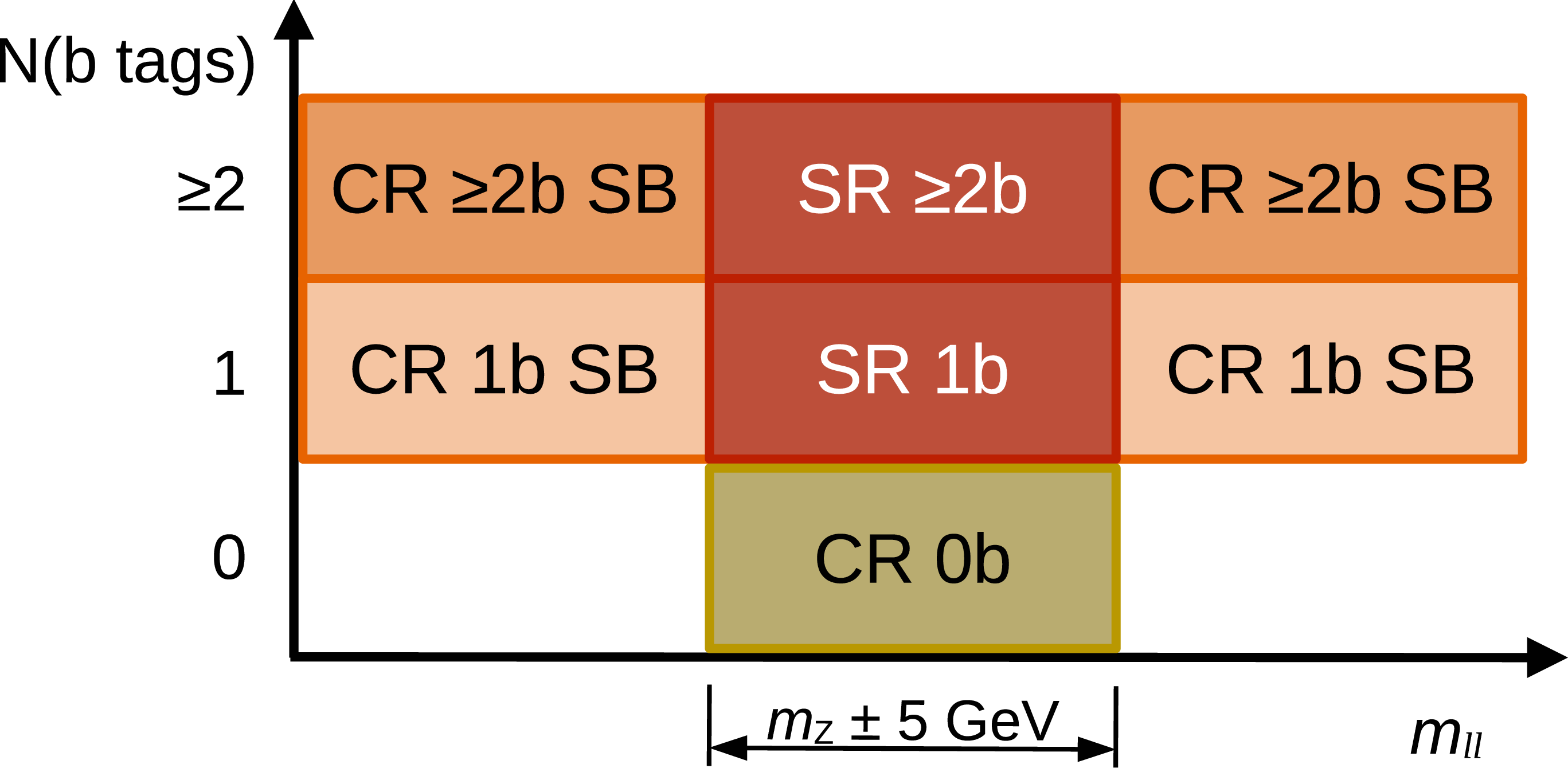 5 categories for Nj=5, Nj>5 each, for ee and mm events separately
5 categories for Nj=5, Nj>5 each, for ee and mm events separatelyDec 5th, 2024
CMS-B2G-23-006
A direct search for new heavy neutral Higgs bosons A and H in the ttZ channel is presented, targeting the process pp → A → ZH with H → tt. For the first time, the channel with decays of the Z boson to muons or electrons in association with all-hadronic decays of the tt system is targeted. The analysis uses proton-proton collision data collected at the CERN LHC with the CMS experiment at √s = 13 TeV, which correspond to an integrated luminosity of 138 fb−1. No signal is observed. Upper limits on the product of the cross section and branching fractions are derived for narrow resonances A and H with masses up to 2100 and 2000 GeV, respectively, assuming A boson production through gluon fusion. The results are also interpreted within two-Higgs-doublet models, complementing and substantially extending the reach of previous searches.
CMS-B2G-23-006
 5 categories for Nj=5, Nj>5 each, for ee and mm events separately
5 categories for Nj=5, Nj>5 each, for ee and mm events separately
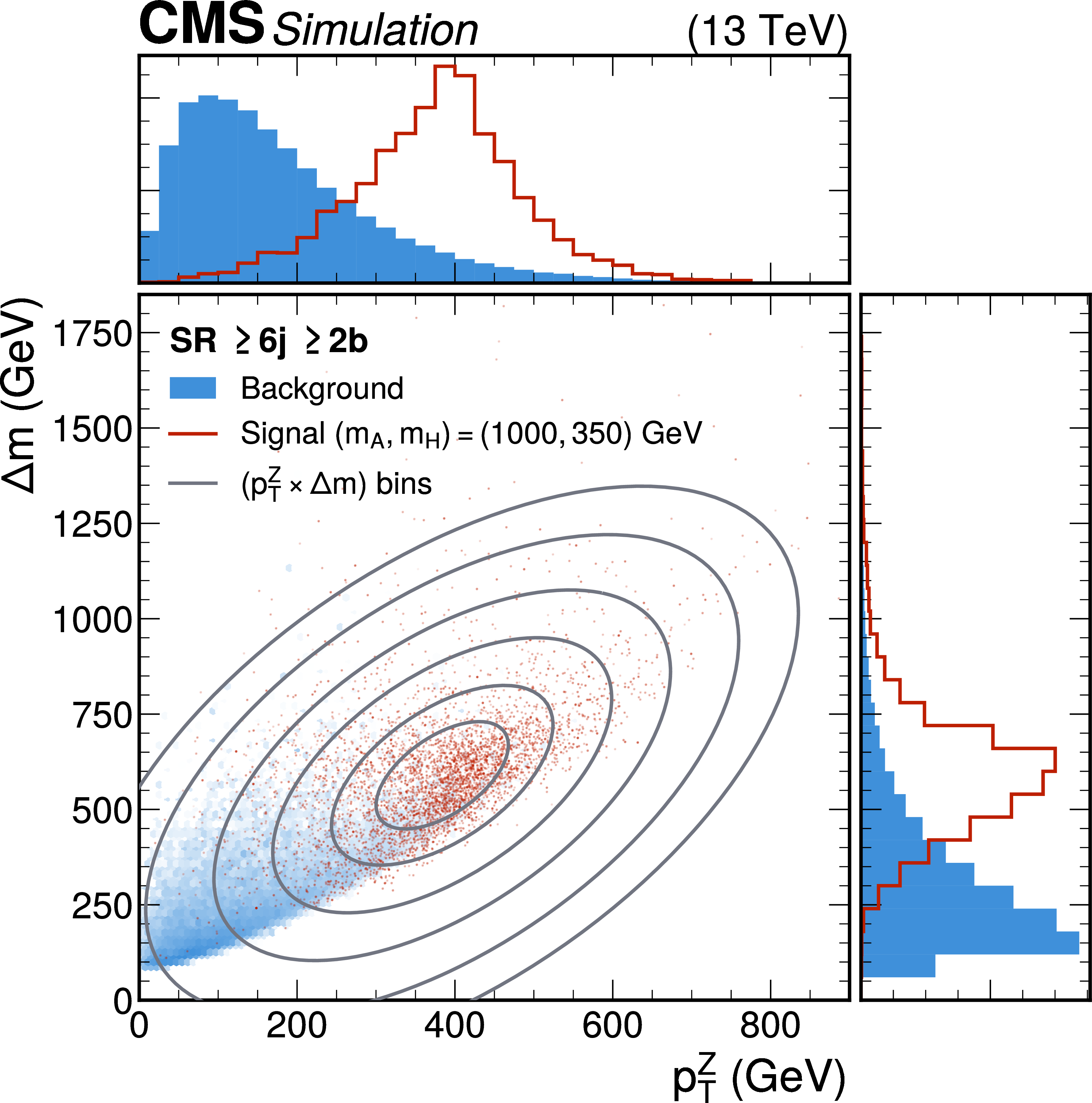

CMS-B2G-23-006
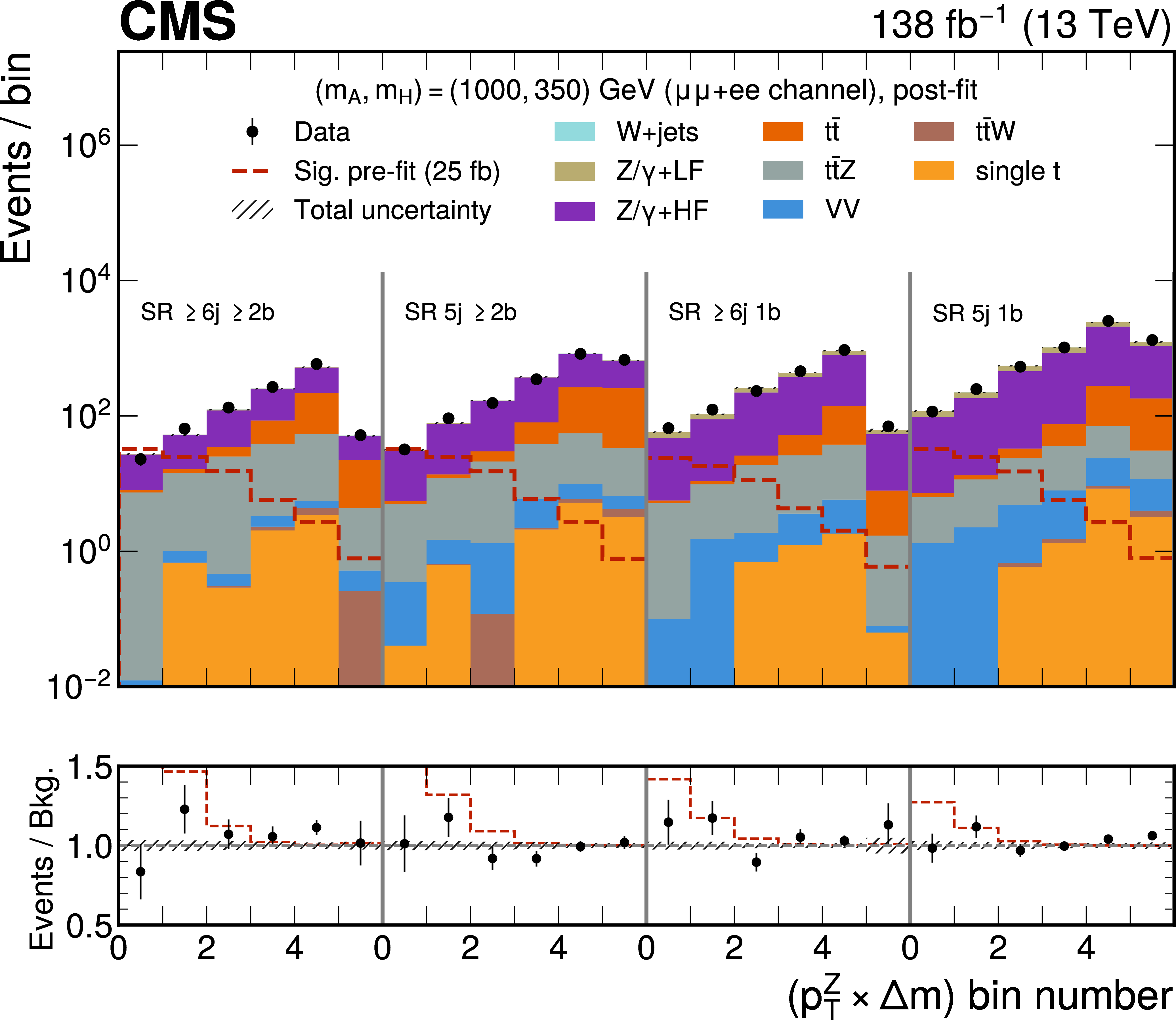
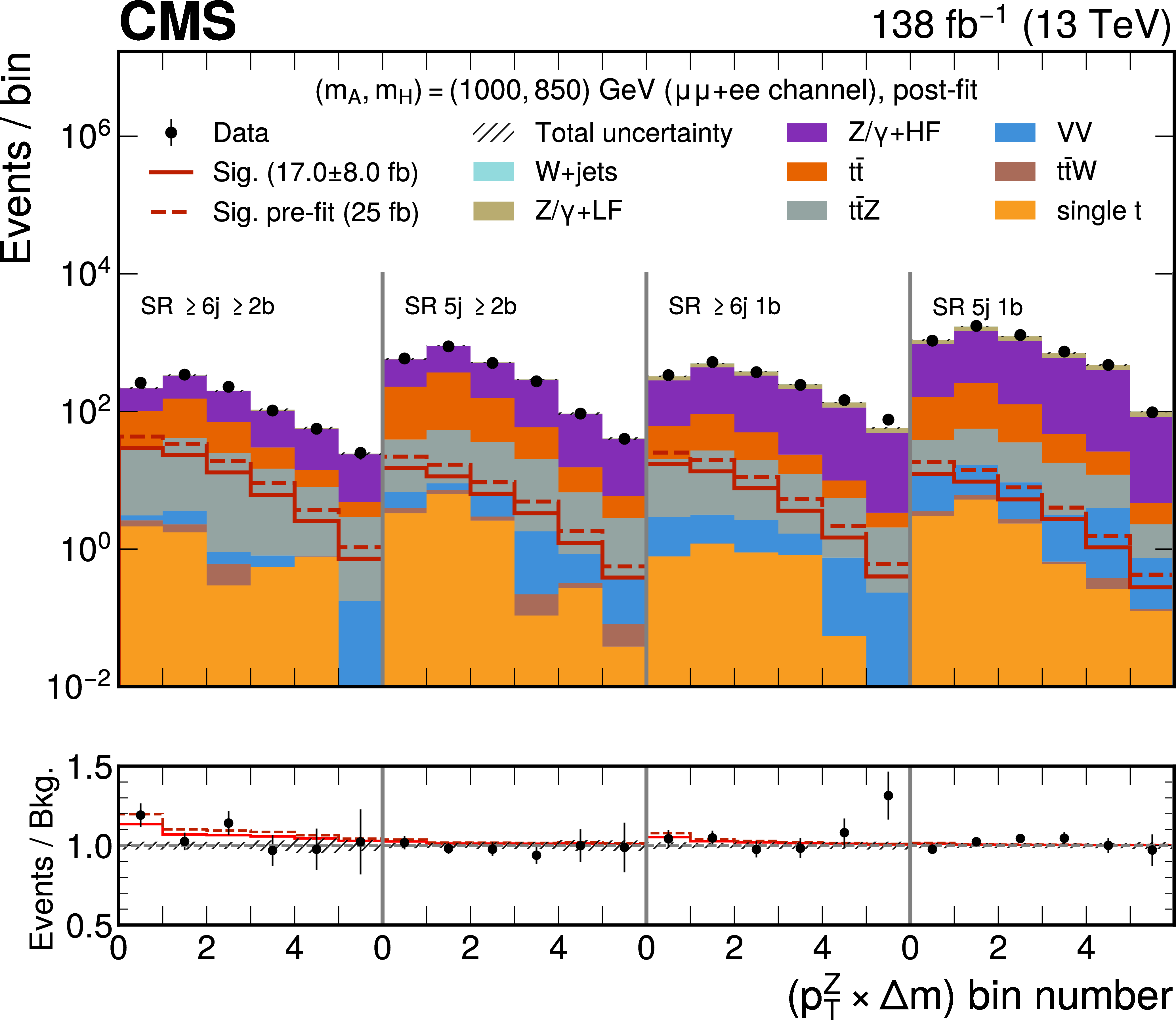
CMS-B2G-23-006
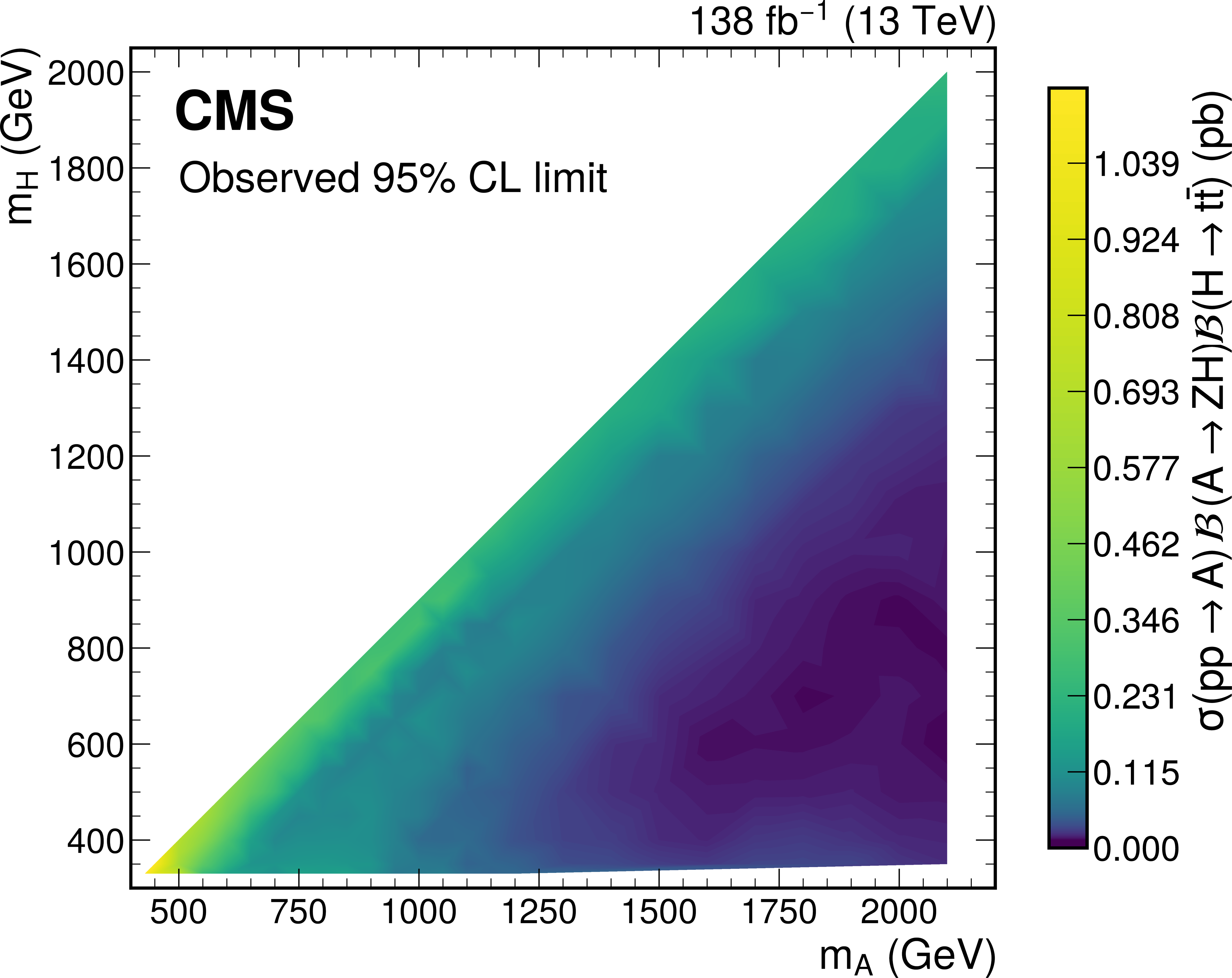
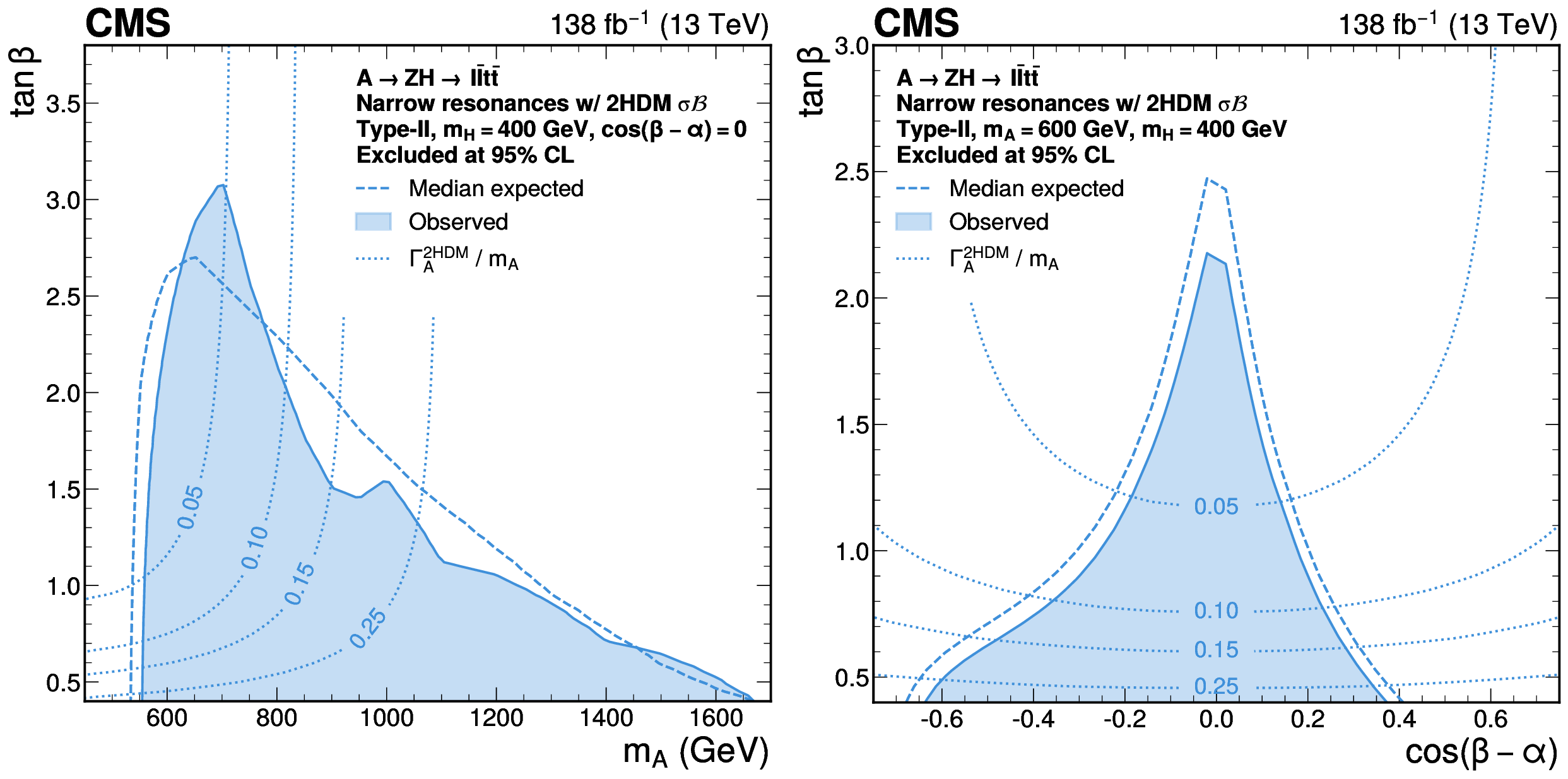
A. Suliga, G. Fuller
The indirect detection of dark matter (DM) through its annihilation products is one of the primary strategies for DM detection. One of the least constrained classes of models is neutrinophilic DM, because the annihilation products, weakly interacting neutrinos, are challenging to observe. Here, we consider a scenario where MeV-mass DM exclusively annihilates to the third neutrino mass eigenstate, which is predominantly of tau and muon flavor. In such a scenario, the potential detection rate of the neutrinos originating from the DM annihilation in our galaxy in the conventional detectors would be suppressed by up to approximately two orders of magnitude. This is because the best sensitivity of such detectors for neutrinos with energies below approximately 100~MeV is for electron neutrino flavor. In this work, we highlight the potential of large-scale DM detectors in uncovering such signals in the tens of MeV range of DM masses. In addition, we discuss how coincident signals in direct detection DM experiments and upcoming neutrino detectors such as DUNE, Hyper-Kamiokande, and JUNO could provide new perspectives on the DM problem.
H. Wu et al.
For decades, researchers have developed task-specific models to address scientific challenges across diverse disciplines. Recently, large language models (LLMs) have shown enormous capabilities in handling general tasks; however, these models encounter difficulties in addressing real-world scientific problems, particularly in domains involving large-scale numerical data analysis, such as experimental high energy physics. This limitation is primarily due to BPE tokenization's inefficacy with numerical data. In this paper, we propose a task-agnostic architecture, BBT-Neutron, which employs a binary tokenization method to facilitate pretraining on a mixture of textual and large-scale numerical experimental data. The project code is available at URL. We demonstrate the application of BBT-Neutron to Jet Origin Identification (JoI), a critical categorization challenge in high-energy physics that distinguishes jets originating from various quarks or gluons. Our results indicate that BBT-Neutron achieves comparable performance to state-of-the-art task-specific JoI models. Furthermore, we examine the scaling behavior of BBT-Neutron's performance with increasing data volume, suggesting the potential for BBT-Neutron to serve as a foundational model for particle physics data analysis, with possible extensions to a broad spectrum of scientific computing applications for Big Science experiments, industrial manufacturing and spacial computing.
R. Barlow, A. Brazzale, I. Volobouev
We present a procedure for handling asymmetric errors. Many results in particle physics are presented as values with different positive and negative errors, and there is no consistent procedure for handling them. We consider the difference between errors quoted using pdfs and using likelihoods, and the difference between the rms spread of a measurement and the 68% central confidence region. We provide a comprehensive analysis of the possibilities, and software tools to enable their use.
ATLAS Collab.
A search for decays of the Higgs boson into a Z boson and a light resonance, with a mass of 0.5-3.5 GeV, is performed using the full 140 fb−1 dataset of 13 TeV proton-proton collisions recorded by the ATLAS detector during Run~2 of the LHC. Leptonic decays of the Z boson and hadronic decays of the light resonance are considered. The resonance can be interpreted as a J/ψ or ηc meson, an axion-like particle, or a light pseudoscalar in two-Higgs-doublet models. Due to its low mass, it would be produced with high boost and reconstructed as a single small-radius jet of hadrons. A neural network is used to correct the Monte Carlo simulation of the background in a data-driven way. Two additional neural networks are used to distinguish signal from background. A binned profile-likelihood fit is performed on the final-state invariant mass distribution. No significant excess of events relative to the expected background is observed, and upper limits at 95% confidence level are set on the Higgs boson's branching fraction to a Z boson and a light resonance. The exclusion limit is 10% for the lower masses, and increases for higher masses. Upper limits on the effective coupling CeffZH/Λ of an axion-like particle to a Higgs boson and Z boson are also set at 95% confidence level, and range from 0.9 to 2 TeV−1.
ATLAS Collab.
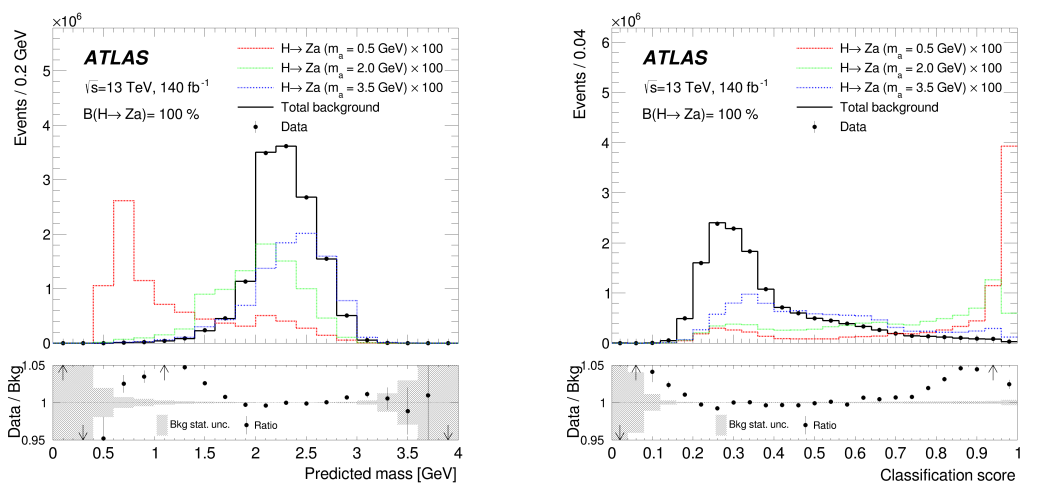
ATLAS Collab.
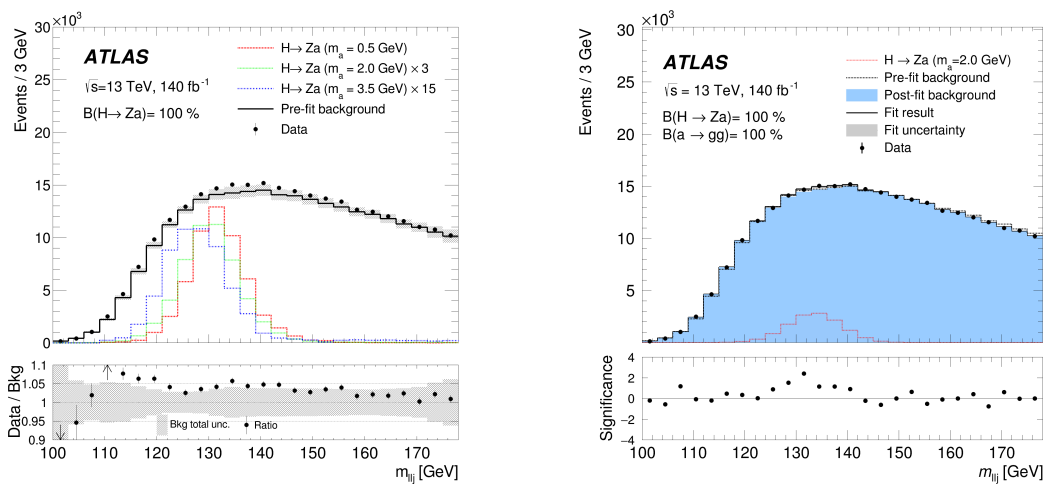
ATLAS Collab.
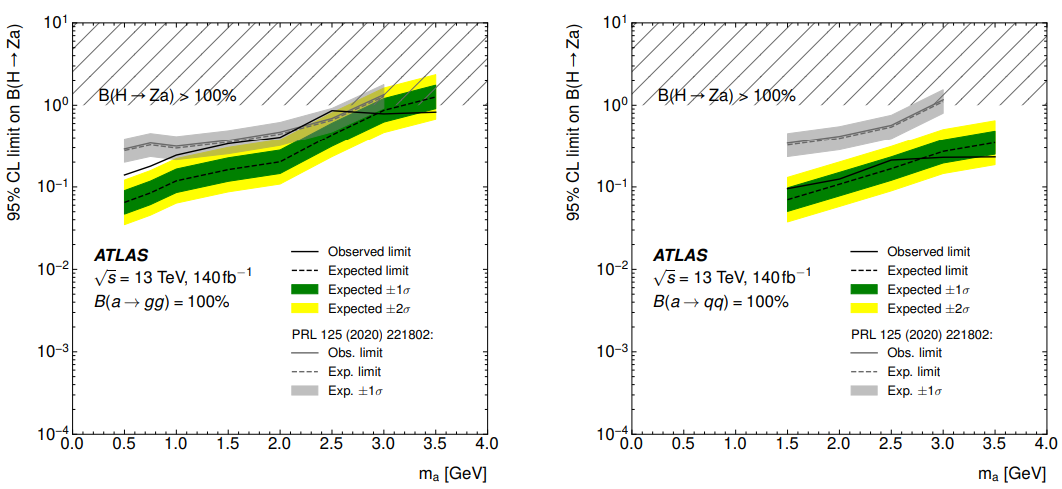
CMS-SMP-24-005
The inclusive WZ production cross section is measured in proton-proton collisions at a centre-of-mass energy of 13.6 TeV, using data collected during 2022 with the CMS detector, corresponding to an integrated luminosity of 34.7 fb−1. The measurement uses multileptonic final states and a simultaneous likelihood fit to the number of events in four different lepton flavour categories: eee, eeμ, μμe, and μμμ. The selection is optimized to minimize the number of background events, and relies on an efficient prompt lepton discrimination strategy. The WZ production cross section is measured in a phase space defined within a 30 GeV window around the Z boson mass, as
σtotal(pp→WZ) = 55.2 ±1.2 (stat) ±1.2 (syst) ± 0.8 (lumi) ± 0.1 (theo) pb.
In addition, the cross section is measured in a fiducial phase space closer to the detector-level requirements. All the measurements presented in this paper are in agreement with standard model predictions.
CMS-SMP-24-005


CMS-SMP-24-005
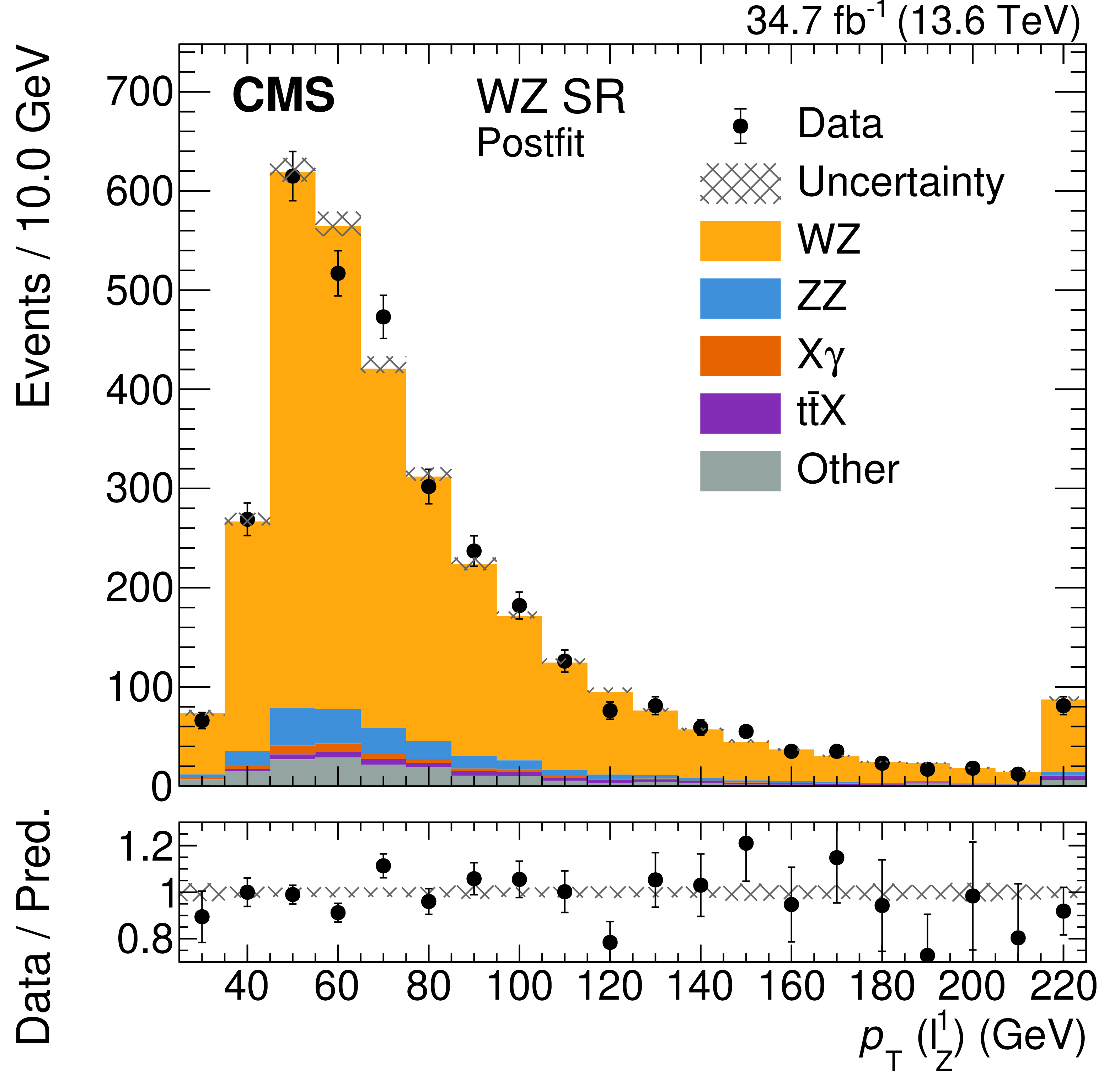
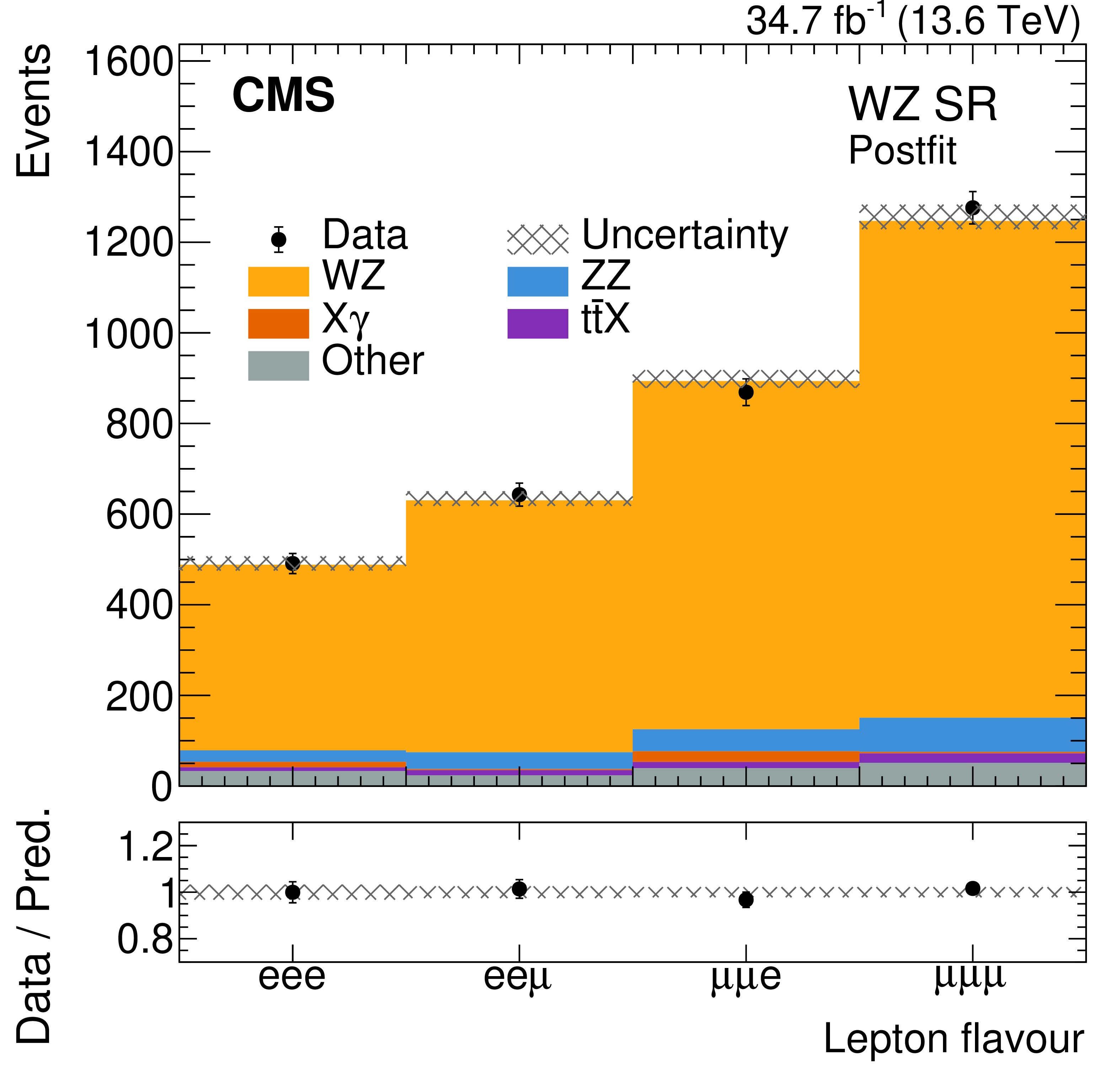
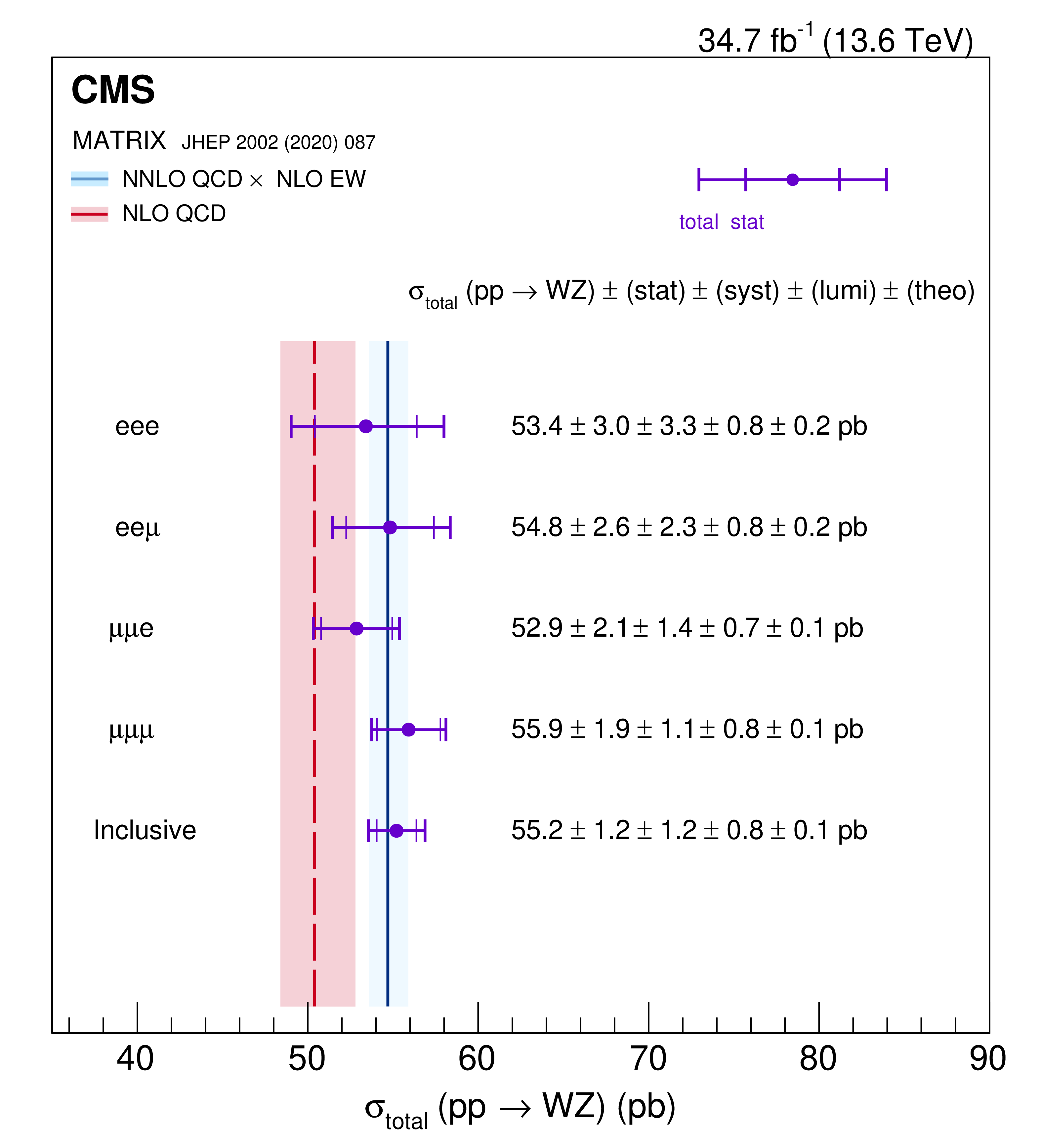
ATLAS Collab.
A measurement of off-shell Higgs boson production in the H*→ZZ→4ℓ decay channel is presented. The measurement uses 140 fb−1 of proton-proton collisions at √s=13 TeV collected by the ATLAS detector at the Large Hadron Collider and supersedes the previous result in this decay channel using the same dataset. The data analysis is performed using a neural simulation-based inference method, which builds per-event likelihood ratios using neural networks. The observed (expected) off-shell Higgs boson production signal strength in the ZZ→4ℓ decay channel at 68% CL is 0.87+0.75−0.54 (1.00+1.04−0.95). The evidence for off-shell Higgs boson production using the ZZ→4ℓ decay channel has an observed (expected) significance of 2.5σ (1.3σ). The expected result represents a significant improvement relative to that of the previous analysis of the same dataset, which obtained an expected significance of 0.5σ. When combined with the most recent ATLAS measurement in the ZZ→2ℓ2ν decay channel, the evidence for off-shell Higgs boson production has an observed (expected) significance of 3.7σ (2.4σ). The off-shell measurements are combined with the measurement of on-shell Higgs boson production to obtain constraints on the Higgs boson total width. The observed (expected) value of the Higgs boson width at 68% CL is 4.3+2.7−1.9 (4.1+3.5−3.4) MeV.
ATLAS Collab.
Neural simulation-based inference is a powerful class of machine-learning-based methods for statistical inference that naturally handles high-dimensional parameter estimation without the need to bin data into low-dimensional summary histograms. Such methods are promising for a range of measurements, including at the Large Hadron Collider, where no single observable may be optimal to scan over the entire theoretical phase space under consideration, or where binning data into histograms could result in a loss of sensitivity. This work develops a neural simulation-based inference framework for statistical inference, using neural networks to estimate probability density ratios, which enables the application to a full-scale analysis. It incorporates a large number of systematic uncertainties, quantifies the uncertainty due to the finite number of events in training samples, develops a method to construct confidence intervals, and demonstrates a series of intermediate diagnostic checks that can be performed to validate the robustness of the method. As an example, the power and feasibility of the method are assessed on simulated data for a simplified version of an off-shell Higgs boson couplings measurement in the four-lepton final states. This approach represents an extension to the standard statistical methodology used by the experiments at the Large Hadron Collider, and can benefit many physics analyses.